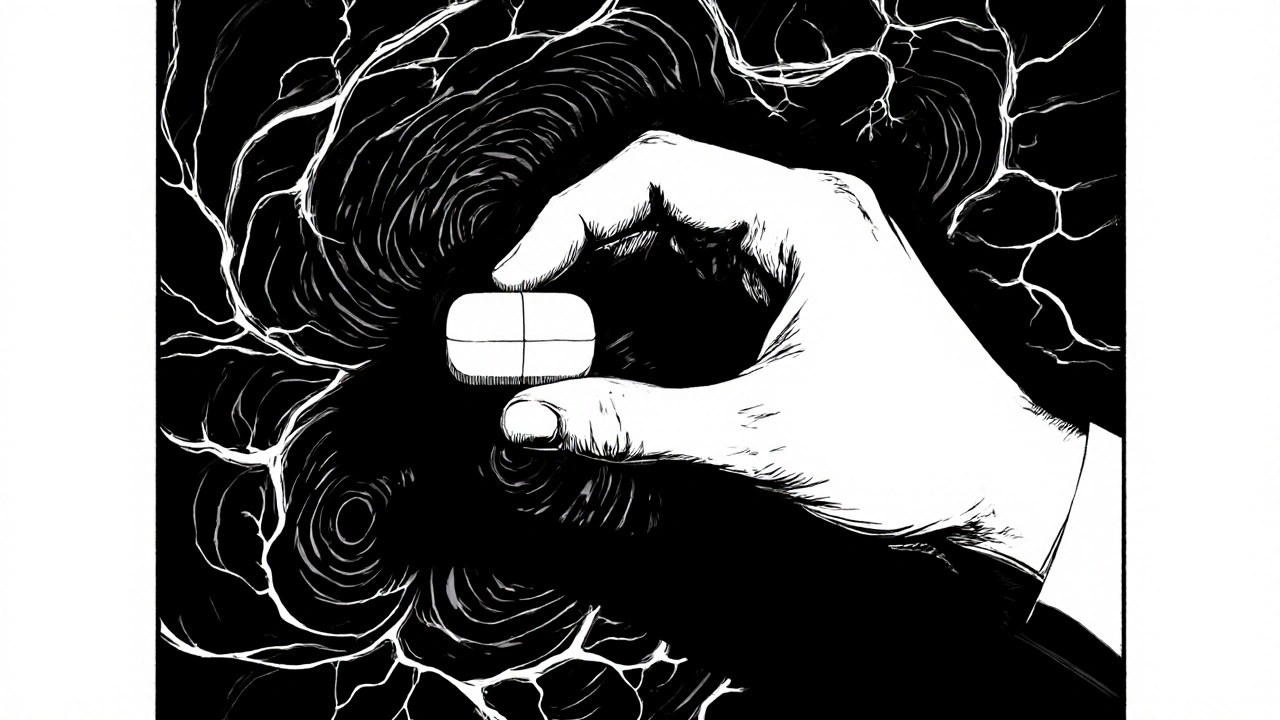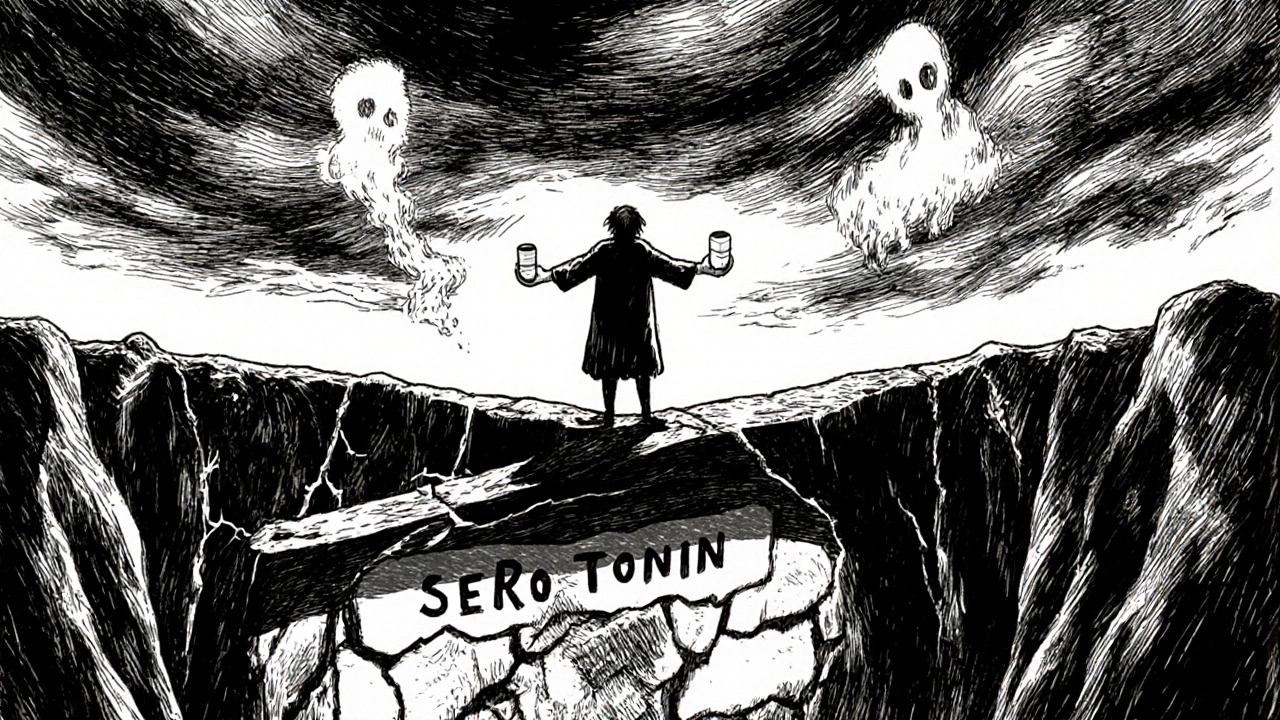
Antidepressant Decision Helper
Find Your Best Antidepressant Match
Select your primary symptoms, side effect concerns, and medical history to get personalized recommendations based on the latest clinical evidence.
Key Takeaways
- Celexa (citalopram) is a well‑tolerated SSRI, best for patients who need a once‑daily dose and minimal drug‑interaction risk.
- Fluoxetine, sertraline and escitalopram share similar efficacy but differ in activation, side‑effect profiles and cost.
- Paroxetine works quickly for anxiety‑dominant depression but carries higher weight‑gain and withdrawal concerns.
- Venlafaxine (an SNRI) may help when pain or fatigue are prominent symptoms.
- Switching between agents requires a cross‑taper plan and close monitoring for serotonin syndrome.
If you’re wondering whether Celexa is right for you, read on.
What Is Celexa (Citalopram)?
Celexa is a prescription medication whose active ingredient is citalopram. It belongs to the class of selective serotonin reuptake inhibitors (SSRIs) and works by increasing serotonin levels in the brain, which helps lift mood and reduce anxiety. First approved by the FDA in 1998, Celexa quickly became a go‑to option for mild to moderate major depressive disorder because of its once‑daily dosing and relatively flat side‑effect curve.
How Celexa Works: The Pharmacology in Plain English
Citalopram blocks the serotonin transporter (SERT) on neurons, preventing the re‑uptake of serotonin back into the presynaptic cell. More serotonin stays in the synaptic cleft, enhancing neurotransmission. The effect isn’t immediate; most patients notice a measurable improvement after 2‑4 weeks, with the full benefit often arriving by week 8.
Typical Dosage and Administration
- Starting dose: 20 mg once daily, usually in the morning.
- Maximum recommended dose for adults: 40 mg daily (caution advised for patients over 60 due to QT‑interval risk).
- Tablets are taken with or without food; consistency helps maintain steady blood levels.
Common Side Effects and Who Should Be Cautious
Most people tolerate Celexa well, but typical adverse events include:
- Dry mouth
- Mild nausea
- Insomnia or drowsiness (dose‑dependent)
- Sexual dysfunction (decreased libido, delayed orgasm)
Patients with a history of cardiac arrhythmia, those taking other QT‑prolonging drugs, and anyone over 65 should discuss dose limits with their clinician.

Choosing an Alternative: What to Compare
When you’re looking at other antidepressants, the main comparison points are:
- Efficacy - How well the drug lifts mood in clinical trials.
- Onset of action - Weeks until patients feel better.
- Side‑effect profile - Weight change, sexual side effects, activation (feeling jittery).
- Drug‑interaction risk - Especially with other serotonergic agents.
- Cost and insurance coverage.
Top Alternatives to Celexa
Below is a quick snapshot of the most frequently prescribed rivals, all of which have robust evidence bases.
| Drug | Class | Typical Starting Dose | Key Advantages | Notable Drawbacks |
|---|---|---|---|---|
| Fluoxetine | SSRI | 20 mg once daily | Long half‑life (once‑weekly dosing possible), energizing effect useful for low‑energy depression. | Insomnia, possible increased anxiety in the first weeks. |
| Sertraline | SSRI | 50 mg once daily | Strong evidence for anxiety disorders, relatively low weight‑gain risk. | Gastro‑intestinal upset common at start. |
| Escitalopram | SSRI | 10 mg once daily | Highest receptor selectivity, often reported as “cleanest” side‑effect profile. | Cost slightly higher than generic citalopram in many markets. |
| Paroxetine | SSRI | 20 mg once daily | Effective for panic and OCD, strong anticholinergic effect can help for certain insomnia patterns. | Weight gain, sexual dysfunction, notable withdrawal syndrome. |
| Venlafaxine | SNRI | 37.5 mg once daily | Additional norepinephrine boost helps with pain and fatigue. | Blood‑pressure rise at higher doses, discontinuation syndrome. |
| Bupropion | NDRI (non‑serotonergic) | 150 mg once daily | Minimal sexual side effects, helpful for smoking cessation. | Can increase anxiety, seizure risk at high doses. |
| Celexa | SSRI | 20 mg once daily | Simple dosing, low interaction potential, generic price. | QT‑interval concerns at >40 mg, modest activation. |
When Celexa Might Be the Better Choice
Consider Celexa if you:
- Prefer a single‑pill regimen with minimal dose‑timing tricks.
- Have a medication list that already includes several QT‑prolonging agents - staying below 40 mg reduces risk.
- Are sensitive to the “activating” feel of fluoxetine or sertraline.
- Need a cost‑effective generic option covered by most insurers.
Scenarios Where an Alternative Shines
Fluoxetine excels for patients who need an energy boost or who have trouble remembering to take a daily pill - its long half‑life allows for once‑weekly dosing after stabilization.
Sertraline is a go‑to for comorbid anxiety because it consistently lowers both depression and anxiety scores in trials.
Escitalopram often wins in patients who have previously experienced intolerable side effects on other SSRIs; its high receptor affinity translates to fewer off‑target complaints.
Paroxetine may be selected for panic‑disorder‑dominant depression, but the clinician must plan a slow taper to avoid withdrawal.
Venlafaxine is the answer when chronic pain, fibromyalgia, or severe fatigue accompany the mood symptoms.
Bupropion is ideal for those whose primary complaint is loss of libido or who also want help quitting smoking.

Switching Between Antidepressants: A Practical Guide
Never stop a medication cold. Most switches require a cross‑taper:
- Reduce the current SSRI by 25 % every 4‑7 days.
- Introduce the new drug at its lowest dose once the previous dose is at 50 %.
- Monitor for serotonin syndrome (agitation, rapid heart rate, tremor) especially if the new agent also raises serotonin.
- Schedule a check‑in after the first two weeks to assess side effects and mood response.
Patients with a history of cardiac issues should have an ECG before and after any dose increase above 20 mg for Celexa.
Cost Considerations (2025 Prices in the UK)
Generic citalopram (Celexa) typically costs £2‑£3 for a 28‑day supply via the NHS. Fluoxetine and sertraline are similarly priced. Escitalopram, being a newer patented molecule, can run £12‑£15 per month unless a generic version is prescribed. Venlafaxine and bupropion often sit in the £5‑£8 range. Insurance formularies frequently favor the cheapest effective option, so discussing “first‑line generic” with the GP can save money.
Bottom Line: How to Pick the Right Pill
Start with your symptom profile:
- Pure low‑energy depression → Celexa or escitalopram.
- Depression with anxiety or panic → Sertraline or paroxetine.
- Need extra activation → Fluoxetine.
- Pain/fatigue dominant → Venlafaxine.
- Sexual side effects are a deal‑breaker → Bupropion.
Then factor in medical history (heart, liver, kidney), current meds, and budget. A shared decision‑making conversation with your prescriber usually lands on the best match within a few weeks of trial.
Frequently Asked Questions
Is Celexa safe for people over 60?
For patients older than 60, clinicians usually cap the dose at 20 mg daily because higher doses raise the risk of QT‑interval prolongation, a cardiac rhythm issue that can lead to arrhythmias.
How long does it take for Celexa to start working?
Most patients notice some mood lift after 2-4 weeks, but the full therapeutic effect often appears by week 6‑8.
Can I take Celexa with over‑the‑counter sleep aids?
Short‑term use of diphenhydramine (Benadryl) is generally okay, but avoid antihistamines that also increase serotonin, like doxylamine, to lower the serotonin‑syndrome risk.
Why do some people feel more jittery on Celexa?
Celexa can raise serotonin enough to cause mild activation in susceptible individuals, especially at the higher end of the dose range. Splitting the dose (e.g., 10 mg twice daily) sometimes eases the feeling.
Is it okay to stop Celexa abruptly if I feel better?
Abrupt discontinuation can trigger withdrawal symptoms like dizziness, “brain zaps,” and mood swings. Tapering down over 2‑4 weeks is the safest route.
Remember, every brain chemistry is unique. The best antidepressant is the one that eases your symptoms with the fewest side effects and fits your lifestyle. Talk openly with your healthcare provider, track how you feel, and adjust as needed.

Hey folks, just wanted to say that picking the right antidepressant is kinda like finding the right pair of shoes – you need something that fits your walk and keeps you comfortable. Celexa’s once‑daily vibe can really simplify a busy schedule, and that simplicity often translates to better adherence. Remember, the brain is a philosophical garden; watering it with steady serotonin can help the flowers of mood bloom. If you’re still on the fence, give the dosage a try at 20 mg and see how you feel after a few weeks – the side‑effects are usually mild, but keep an eye out for any dry mouth or insomnia. And hey, don’t forget to talk to your doc about any heart‑related concerns, especially if you’re over 60 – they’ll probably cap the dose at 20 mg to keep the QT interval safe. Stay hopeful and keep tracking your mood, because small wins add up. Definately worth a shot for many people.
It is my considered opinion that a balanced evaluation of Celexa relative to its alternatives should be conducted with the utmost civility and respect for differing clinical experiences. While the pharmacodynamic profile of citalopram is indeed commendable for its tolerability, one must not overlook the nuanced distinctions in activation potential exhibited by fluoxetine or sertraline. Moreover, the economic implications, particularly within the United Kingdom's NHS framework, merit careful scrutiny. I advocate for an open dialogue between prescriber and patient, wherein therapeutic goals, comorbid conditions, and financial constraints are transparently discussed. Such a collaborative approach invariably fosters adherence and optimises outcomes.
Choosing an antidepressant can feel like navigating a labyrinth, but let me walk you through the process step by step. First, it is essential to identify the core symptoms that trouble you the most-whether it is low energy, persistent anxiety, or physical pain that shadows your days. Celexa, with its gentle serotonergic lift, often shines when the primary challenge is a steady low‑grade depression without a heavy anxiety overlay. If you find that anxiety or panic attacks dominate your experience, sertraline or paroxetine might provide a more targeted benefit because they have stronger anxiolytic properties. On the other hand, when fatigue and musculoskeletal pain accompany your mood swings, an SNRI such as venlafaxine can address both serotonin and norepinephrine pathways, potentially offering greater relief. Cost considerations also play a pivotal role; generic citalopram is usually the most affordable option, which can be a decisive factor for many patients under tight budget constraints. Age is another variable-patients over 60 should remain cautious about QT‑interval prolongation, limiting the dose to 20 mg daily. For younger individuals, the flexibility to titrate up to 40 mg may be acceptable if the physician deems the cardiac risk low. It is worth noting that the onset of therapeutic effect typically emerges after two to four weeks, with the full benefit often manifesting by week eight, regardless of the specific agent. Patience during this period is crucial; premature switching can muddle the assessment of true efficacy. When a switch becomes necessary, a cross‑taper strategy-reducing the current SSRI by about a quarter every five to seven days while introducing the new medication at its lowest dose-helps mitigate withdrawal and serotonin‑syndrome risks. Monitoring for side‑effects such as insomnia, gastrointestinal upset, or sexual dysfunction should be a collaborative effort between you and your prescriber, with adjustments made as needed. Remember that each person’s neurochemistry is unique, and what works splendidly for one may fall short for another, so an open‑minded approach to trial and error is vital. Lastly, keeping a simple mood diary can illuminate subtle changes that might otherwise go unnoticed, empowering you to make informed decisions with your clinician. In summary, weigh symptom profile, side‑effect tolerance, age‑related considerations, and economic factors when selecting an antidepressant, and maintain clear communication with your healthcare team throughout the journey.
In the grand theater of mental health, every pill is a character playing its part, 🎭 and sometimes the script feels written by an unseen hand. Celexa may appear as the quiet protagonist, yet its subtle activation can whisper louder than we expect. One could argue that the very act of choosing a medication is an exercise in existential freedom-what else but a declaration of agency in a world of chemical determinism? 😌 While some champion fluoxetine for its energizing flair, others find solace in the understated consistency of citalopram. It’s all a matter of perspective, much like debating whether the glass is half full or merely a vessel for future reflections. 🤔 Let’s honor the diversity of experiences without descending into polarizing dogma; after all, the therapeutic journey is as personal as a sunrise.
Look, the pharma industry doesn’t just hand out meds for free; there’s a whole network of influence that steers prescribing patterns. They push Celexa because it’s cheap enough to keep insurance payouts low, yet generic enough to hide the profit margins they make on brand‑name hype. Meanwhile, newer agents like escitalopram get marketed as “superior,” even though the clinical differences are marginal. The reality? Most of these drugs were discovered by big labs that also fund the journals where you read about their “efficacy.” So, while your doctor might say “Celexa is a solid first‑line choice,” be aware that the recommendation could be nudged by data that serves corporate interests. Stay informed, ask for raw study data, and never accept a prescription without understanding the hidden agenda.
Hey everyone, just a quick heads‑up: if you’re on Celexa and notice a bit of jitteriness, try splitting the dose-10 mg in the morning and 10 mg in the afternoon. It often smooths out the activation without losing efficacy. Also, keep a short symptom log; it makes the follow‑up visit with your GP much more productive. And remember, most side effects settle after the first few weeks, so give it a solid month before deciding it’s not for you.
Celexa works fine for me.
Wow, another groundbreaking revelation that Celexa is “well‑tolerated”-who could have predicted that a selective serotonin reuptake inhibitor would be less likely to cause serotonin syndrome than a double‑espresso? In the era of personalized medicine, we’re apparently still stuck with the same old trial‑and‑error protocol, complete with cross‑tapering matrices and therapeutic drug monitoring that feels more like a bureaucratic checklist than a nuanced clinical decision. If you’re looking for a “clean” side‑effect profile, maybe consider a non‑pharmacologic approach; but hey, if you like navigating insurance formularies and dealing with generic pricing wars, by all means, keep popping those 20 mg tablets.
Celexa’s modest efficacy makes it a reasonable baseline, but it rarely excels where rapid activation is needed.
Alright, let’s break this down together: if you’re mainly battling low mood with occasional anxiety, Celexa’s steady serotonin boost can be a solid start. If anxiety spikes are more intense, think about sertraline; if you need a bit of extra energy, fluoxetine might be the ticket. And hey, don’t forget lifestyle tweaks-regular exercise, consistent sleep, and a balanced diet can amplify whatever medication you choose. Feel free to share how you’re doing; the community can help fine‑tune the plan.
Honestly, most people seem to think that picking an antidepressant is as easy as choosing a flavor of ice cream, but the reality is far more complex than that superficial analogy suggests. You have to consider pharmacodynamics, pharmacokinetics, individual metabolism, and even genetic polymorphisms that can affect how the drug is processed in the body. Celexa, also known as citalopram, has a relatively straightforward mechanism-blocking the serotonin reuptake transporter-yet its half‑life and dose‑dependent QT prolongation risk make it less universally suitable than some would claim. For younger patients with no cardiac history, starting at 20 mg is usually fine, but for those over sixty, the max dose should be trimmed to 20 mg due to the potential for arrhythmic events, a detail that many prescribers overlook. On the other hand, fluoxetine’s long half‑life can be a double‑edged sword: it provides a smoother withdrawal profile but also means it stays in the system longer, potentially interacting with other serotonergic agents. Sertraline’s balanced efficacy across depression and anxiety makes it a versatile choice, yet some patients report gastrointestinal upset during the titration phase, which can be mitigated by taking the medication with food. Escitalopram, the S‑enantiomer of citalopram, offers higher receptor selectivity, which translates to fewer off‑target side effects, but its higher price tag in many markets can be a barrier for patients without comprehensive insurance coverage. Moreover, if your primary complaint includes physical pain or chronic fatigue, an SNRI like venlafaxine may be more appropriate because it also boosts norepinephrine. Don’t forget about non‑serotonergic options like bupropion, especially if sexual side effects are a major concern-its dopaminergic activity can actually improve libido while also aiding smoking cessation. That said, bupropion can increase anxiety in susceptible individuals, so a thorough assessment of baseline anxiety levels is essential before initiating therapy. Finally, when switching from one antidepressant to another, a cross‑taper plan isn’t just a recommendation; it’s a safety protocol to avoid serotonin syndrome and discontinuation syndrome, both of which can be debilitating. So, in summary, the “best” antidepressant is highly individualized, and a collaborative conversation with your healthcare provider-taking into account symptom profile, side‑effect tolerance, comorbid conditions, and financial considerations-will ultimately guide you to the most suitable choice.
The data on Celexa is nothing short of average-meta‑analyses show effect sizes hovering around 0.3, which barely clears the minimal clinically important difference threshold. Its side‑effect profile is decent, but the QT prolongation risk, especially at doses above 20 mg for older adults, cannot be dismissed as a trivial footnote. Moreover, when you stack it with other serotonergic agents, the probability of serotonin syndrome spikes dramatically, a fact that’s often downplayed in patient handouts. In cost‑benefit terms, generic citalopram wins on price, yet the marginal benefit over cheaper options like fluoxetine is questionable. Bottom line: Celexa is a passable, but unremarkable, choice unless you have a specific intolerance to other SSRIs.